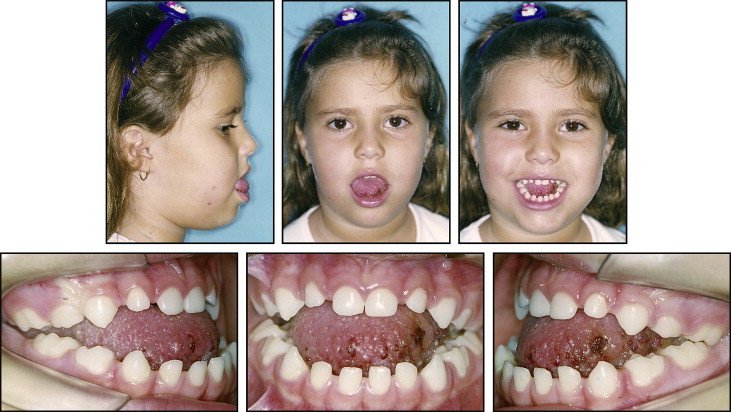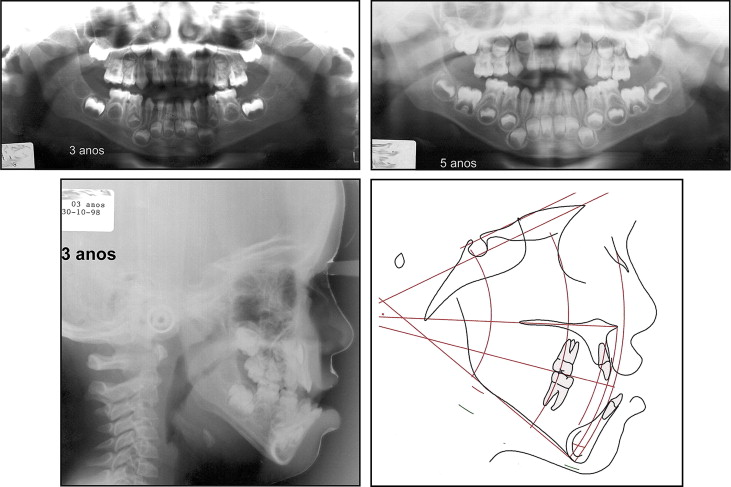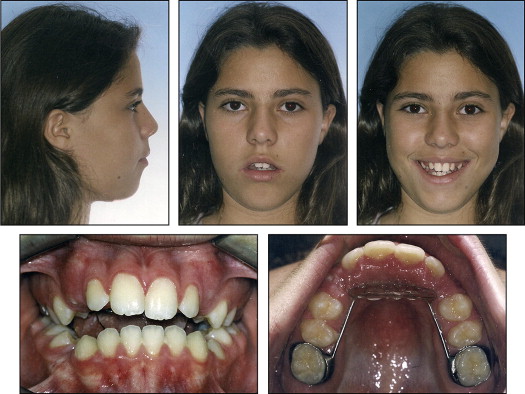The interceptive orthodontic treatment of patients with complex dentofacial abnormalities is frequently inefficient and produces less than ideal outcomes. Therefore, postponing therapy to a single-phase surgical-orthodontic approach might be considered a reasonable option. However, other relevant aspects of the patient’s quality of life, such as possible psychosocial problems and functional impairments, should also be considered before deciding whether to intercept a severe dentofacial malocclusion while the patient is still growing, or wait and treat later. This case report describes the nonsurgical treatment of a young patient with a severe Class III open-bite malocclusion associated with a cervical cystic lymphangioma. Despite the poor interceptive therapy prognosis, a 2-phase approach was effective. A reflection about giving up efficiency in favor of effectiveness, functional rehabilitation, and the patient’s quality of life is included.
The treatment of patients with complex dentofacial abnormalities is always a great challenge to orthodontists. Intercepting these problems early frequently lowers the efficiency of treatment because of an excessive treatment time, often without improving the efficacy. When orthodontists examine children with malocclusions severely affecting at least 2 planes of space, postponing therapy to a single-phase surgical-orthodontic approach might be considered a reasonable treatment option. However, as an essential member of any craniofacial team, an orthodontist must consider other relevant aspects of the patient’s quality of life, such as possible psychosocial problems and functional impairments. These variables should also be considered before deciding whether to prescribe early treatment for a severe dentofacial malocclusion.
Several environmental factors can be associated with the development of a complex skeletal malocclusion. The macroglossia and the anterior tongue posture caused by a cervical cystic lymphangioma (cystic hygroma) exemplify some of these etiologic determinants. Children with neoplastic lesions of the tongue usually develop major myofunctional imbalances, resulting in significantly abnormal craniofacial growth patterns. The aim of this article was to report the treatment of a patient with a severe malocclusion caused by a cervical cystic lymphangioma in which the interceptive phase was effective but not efficient. A reflection about giving up efficiency in favor of effectiveness, functional rehabilitation, and patient’s quality of life is included.
Diagnosis and etiology
A 3-year-old girl was referred to an orthodontic office, and her mother’s main concern was “the need to do something to hold the tongue.” The child was born with a cervical cystic lymphangioma, and her tongue was visibly enlarged already in her first year of life. Posterior cervical masses were fingerlike processes extending bilaterally into the tongue. The child had neck resection of the lesions when she was 2 months old. Complete surgical excision of the cystic lesions was not possible because of the marked lymphangiomatous infiltration in the muscle fibers of the tongue. When she was 2 years old, a wedge glossectomy was performed to decrease the tongue’s size.
Clinically, she had a straight profile, severe lip incompetence, and a striking tongue protrusion ( Fig 1 ). The intraoral examination showed a full-step mesiocclusion with 10 mm of negative overjet, a posterior cross-bite tendency, and a severe anterior open bite (8 mm) ( Fig 2 ). The only occlusal contact was between the left second deciduous molars, and the erythematous lesions on the tongue were still quite evident ( Fig 1 ). The cephalometric evaluation ( Fig 3 ) with the Sassouni archeal analysis showed a skeletal Class III relationship despite the borderline ANB angle (−0.6°). There was also a severe vertical discrepancy confirmed by the steep mandibular plane angle (FMA, 30.6°; SN-GoGn, 42.7°) ( Table ). The panoramic radiograph showed, at the age of 3, incomplete root formation of the maxillary second deciduous molars; this was completed by the age of 5 years ( Fig 3 ). The child’s father had a Class III malocclusion, and her mother also showed signs of a Class III profile.



| Measurement | Pretreatment | After phase 1 | After phase 2 |
|---|---|---|---|
| SNA (°) | 81.7 | 79.7 | 79.8 |
| SNB (°) | 82.3 | 77.0 | 77.8 |
| ANB (°) | 0.7 | 2.7 | 2.8 |
| SNGoGn (°) | 42.7 | 45.2 | 44.9 |
| ArGoGn (°) | 145.3 | 138.9 | 134.2 |
| NSGn (°) | 68.8 | 74.9 | 74.6 |
| FMA (°) | 30.6 | 37.2 | 35.1 |
| U1.NA (°) | 10.9 | 24.9 | 24.0 |
| U1-NA (mm) | 1.1 | 8.3 | 5.9 |
| L1.NB (°) | 34.1 | 10.1 | 27.3 |
| L1-NB (mm) | 9.1 | 4.1 | 8.7 |
| IMPA (°) | 88.1 | 64.7 | 82.2 |
| U1.L1 (°) | 134.3 | 135.1 | 127.5 |
Treatment objectives
After the orthodontic team carefully reviewed the patient’s initial records, her parents received a detailed explanation about the poor prognosis of any interceptive orthodontic approach. Heredity, severity of the malocclusion, and the difficulty in controlling the tongue habit since the tumor could not be fully removed were mentioned as significant complicating factors. Because the efficacy and efficiency of an early treatment phase had an unfavorable prognosis, a surgical-orthodontic intervention at the end of growth was the first treatment option presented. However, the patient’s mother was a dentist, and she adamantly refused postponing any interceptive intervention. Therefore, an alternative treatment plan was formulated, and its objectives were to try to (1) control the sagittal, vertical, and transverse dentofacial abnormal growth tendencies; (2) correct both molar and canine relationships to Class I relationships; (3) obtain normal incisor relationships; (4) develop a more adequate masticatory function; (5) improve lip closure and facial esthetics; and (6) develop a better muscular balance to increase the chances of obtaining stable results.
Treatment objectives
After the orthodontic team carefully reviewed the patient’s initial records, her parents received a detailed explanation about the poor prognosis of any interceptive orthodontic approach. Heredity, severity of the malocclusion, and the difficulty in controlling the tongue habit since the tumor could not be fully removed were mentioned as significant complicating factors. Because the efficacy and efficiency of an early treatment phase had an unfavorable prognosis, a surgical-orthodontic intervention at the end of growth was the first treatment option presented. However, the patient’s mother was a dentist, and she adamantly refused postponing any interceptive intervention. Therefore, an alternative treatment plan was formulated, and its objectives were to try to (1) control the sagittal, vertical, and transverse dentofacial abnormal growth tendencies; (2) correct both molar and canine relationships to Class I relationships; (3) obtain normal incisor relationships; (4) develop a more adequate masticatory function; (5) improve lip closure and facial esthetics; and (6) develop a better muscular balance to increase the chances of obtaining stable results.
Treatment alternatives
Two treatment plans were presented to the patient’s parents. The first option was to wait until craniofacial growth was completed and perform surgical-orthodontic treatment. However, the patient’s mother expressed her deep concerns about the psychosocial problems her daughter had been facing. Consequently, she refused the first treatment plan proposed and insisted that some interceptive therapy be performed to try to improve her daughter’s oral function and facial harmony. Therefore, an alternative 2-phase treatment plan was developed. It consisted of a first phase of dentofacial orthopedics to try to induce a more harmonious growth pattern and improve function and facial esthetics. The second phase of treatment would consist of fixed orthodontic appliances to correct the remaining dentoalveolar discrepancies. The parents were carefully informed that the first phase would not necessarily eliminate the need for orthognathic surgery during the second phase of treatment. They were also aware that the stability of the results would be a challenge. After thorough deliberation of the advantages and disadvantages of both treatment options, the parents chose the 2-phase therapy and signed an informed consent authorizing the treatment of their daughter.
Treatment progress
Phase 1 treatment started when the panoramic radiograph showed complete root formation of the maxillary second deciduous molars. The patient was 5 years old, and her behavior in the dental chair was acceptable for performing orthodontic procedures. Rapid palatal expansion was carried out with a hyrax expander; immediately after the last screw activation, maxillary protraction with a Delaire facemask began. Five hundred centinewtons of force per side were applied, and 12 to 16 hours of daily wear were requested. However, the patient’s compliance was poor; after 6 months of treatment, the facemask therapy was discontinued.
Our failure to obtain adequate cooperation with facemask wear led us to raise questions about the success of the interceptive treatment. However, the patient’s mother was satisfied with the improvement of both the posterior and anterior open bites, as well as the better canine relationship. Therefore, she once again insisted that another attempt to control the poor growth tendencies should be made. The patient then received a chincup with vertical-pull traction for nighttime wear to try to control the excessive vertical growth pattern. In addition, a fixed acrylic tongue crib was inserted in the maxillary arch ( Fig 4 ). The acrylic crib was chosen because of the risk of injuring the child’s tongue lesions if a conventional wire-only crib was used. After the crib was inserted, the patient could not thrust her tongue outside her mouth ( Fig 4 ). Therefore, she developed a better tongue posture, improved her speech pattern, and her social behavior. She also became a more cooperative patient, increasing her adherence to the interceptive orthodontic treatment.
Progress records were taken 3 and 6 years after tongue crib and chincup insertion ( Fig 5 ). They showed favorable growth between the maxilla and the mandible. After cautiously studying the progress records, we concluded that the remaining skeletal malocclusion could be camouflaged with fixed orthodontic appliances after the completion of her craniofacial growth. Follow-up consultations were scheduled bimonthly to check the status and adjust (if necessary) both the tongue crib and the chincup.
However, when the patient reached adolescence at 12 years of age ( Figs 6 , 7 , 8 , and 9 ), she refused to keep wearing the chincup and asked us to start the next phase of treatment with fixed appliances. She was at stage 3 of cervical vertebral maturation, and her hand-wrist radiograph showed that she was at the peak of her pubertal growth ( Fig 8 ). Maxillary and mandibular fixed appliances (0.022-in slot brackets) were bonded, leveling and alignment took place satisfactorily, and the mandibular arch-space discrepancy caused by the lingual inclination of the mandibular anterior segment was corrected ( Figs 10 and 11 ). Vertical, triangular, quarter-inch, 4.5 oz elastics were used in the canine region bilaterally to improve intercuspation. Class III elastics (3/8 in, 6.5 oz) were used to maintain some growth-restraining forces when the 0.019 × 0.025-in archwires were in place. The overall second phase of treatment lasted 22 months, and debond was performed when the patient achieved stage 6 of cervical vertebral maturation ( Fig 12 ). Fixed retention was bonded on both the mandibular (canine to canine) and the maxillary (first premolar to canine on each side) arches to minimize the chances of open-bite relapse. The patient was also instructed to wear a maxillary Essix retainer (type C+; DENTSPLY Raintree Essix, Sarasota, Fla) at night.





